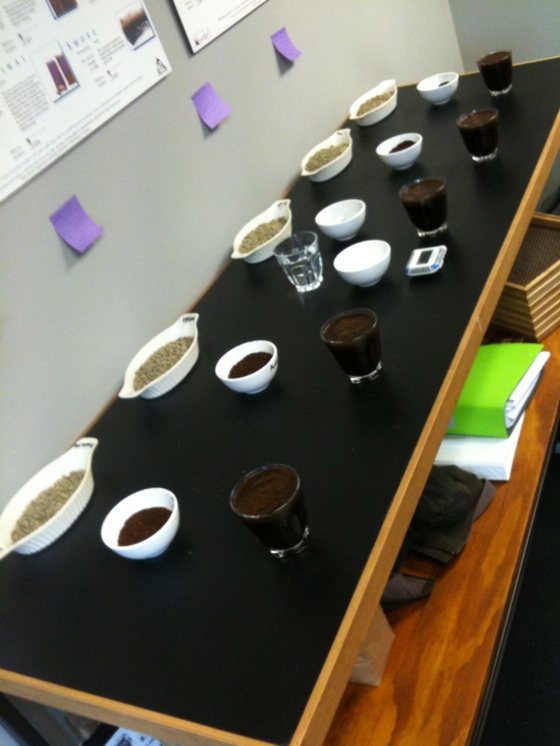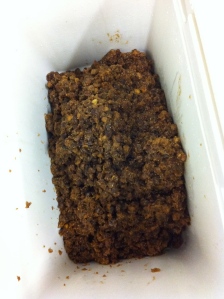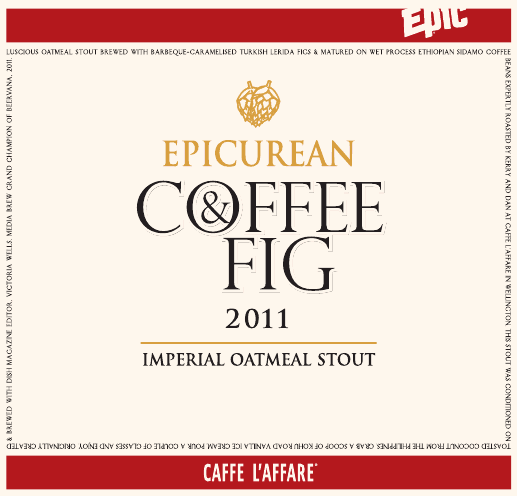Sometimes the road to creating a beer can be a long one. Brewers of old, with their porters aged in vats, 21 year old ales and the like, as well as those more modern brewers of wood-aged loveliness would testify to that statement. Sure, brewers are slightly more impatient than winemakers or whiskey producers when it comes to wanting to make something drinkable as quickly as possible, but there are times when we have to realise that some things take exactly that… time.
Our latest beer has been a six month labour of love, and that was just us getting to brew day! Not all brews have this much time and energy invested into them, but this one has been fun, had a lot of challenges and will hopefully be a great beer.
Back at Thornbridge, I worked with Simon Bower of Pollards Coffee and we developed a scrumptious Coffee Milk Stout with a blend of beans. I’m a massive coffee fan, so it was a fun project and involved lots of coffee bean steeping trials as well as some labour intensive lactose dissolution (thanks to James Kemp of Buxton Brewery for that!). Lactose is not a big fan of dissolving in water, but as JK found out, stirring will get you there eventually 🙂 The resulting beer turned out exactly as hoped, it was like drinking a cool, slightly alcoholic pint of slightly sweet coffee, replete with crema on top (the joys of handpulled cask-conditioned ale).
With that experience in mind, I thought it would be pretty cool to work with a New Zealand coffee roastery and sent out a few emails to the New Zealand Coffee Roasters Association, who then put me in touch with Jess Godfrey from Caffe L’affare, a roastery based in Wellington. She was really excited about the concept and so began the process of choosing the beans that had the characteristics we were looking for. I was sent some analysis sheets from the roasters at L’affare, Kerry and Dan and went through their cupping notes. Cupping is the process in which the flavour and aroma characteristics of the roasted, ground beans are ascertained and involves weighing a set amount of ground beans, placing with hot water and going through a series of sensory analyses. But more about that later…
The initial samples that Caffe L’affare sent us were Guatemalan Asobagri, Ethiopian Yirgacheffe, Ethiopian Sidamo, Colombian Pitalito Huila, Brazilian Monte Alegre and Honduran. Sample bags were cracked open in our office and we nosed through them all. The way of using the beans in the brew meant we were looking for aromatics more than anything else. The roaster’s tasting notes described fragrance, aroma, sweetness, acidity and flavour amongst others, so we looked at our notes and compared them to theirs. There were a couple of beans in particular that really stood out for us and they were both from Ethiopia – the Sidamo and Yirgacheffe and they both exhibited a dominant citrus character, with a subtle floral background. The only way to really know for sure that the character would work in a beer though was to brew one.
As luck would have it, Epic was due to take part in the Beervana Media Brew Challenge in which brewers were paired off with media pundits from around New Zealand. We were paired with Victoria Wells, Editor of Dish magazine, whilst other brewers were paired with the following; Writer Haydn Green and Paul Croucher of Croucher’s (Rotorua); radio broadcast journalist Sean Plunket and Carl Vasta of Tuatara; Simon Morton of Radio NZ’s This Way Up and Stu McKinlay of Yeastie Boys (Wellington); Lucas de Jong of TVNZ Breakfast and Pete Gillespie of The Garage Project (a Wellington brewery launching this week); Geoff Griggs, beer writer, and Soren Eriksen of 8 Wired (Blenheim); Matt Markham of The Press and Ralph Bungard of Three Boys (Christchurch) and Michael Donaldson of Sunday Star Times with Richard Emerson of Emerson’s (Dunedin).
Victoria came along for the day to brew with us on our little ePicobrewery set up and we decided to mix things up a bit and use some Turkish Figs in the boil. Initially just a fun idea, we realised that these were gonna add some interesting character to the brew. To get as much character as possible out of the figs, I caramelised them up with some of the Stout wort, which resulted in a sticky, delicious mess, and internalised vocalisations of that “Now, bring us some figgy pudding” song. Probably lucky for Victoria and Luke that I internalised them, to be honest.
The stout itself was a blend of malts. The Malt of Champions, Maris Otter made up the bulk of the grist and was accompanied by it’s good friend, Mr. Oat Malt and a few of their ragtag bunch o’ friends, namely Mike Melanoidin, Andrew Abbey, Chris CaraAroma, Carol CaraAmber…
At this point in time, my great idea of personifying malt types as if they were members of a motley Munch Bunch instantly faded into oblivion. It just didn’t seem to work at all. Damn it. The other malts we used were Black, Pale Chocolate, Chocolate and Roast Barley.
This was quite a complex grist, but in the back of my mind, I always ponder the legs of a stout. If it’s gonna be a bit on the strong side and you can get the grist just right, then you’re going to have something that will reward you over time as it matures away in the bottle. The chunky, intense CaraAmber and CaraAroma were there to provide some body and some ageing potential… Initially, these malts can come across slightly intense with a roasted bitterness, especially when combined with the other dark malts in the beer, but as the beer ages away (somewhere cool and dark, not on your windowsill in the kitchen!), they push out complexity, they soften and they open up a world of new flavours. I love the darker malts for these exact reasons. They are like inverted assassins… hiding in the wilderness, being patient, then all of a sudden leaping out and unkilling a bunch of great flavours.
The water for the mash has also been treated with Calcium sulphate (gypsum) and Sodium bicarbonate (baking soda). The Auckland water is quite soft and it was important to get this right. Calcium is important for some of the enzymes that work away during the mash rest, helping to reduce the pH and providing some heat stability to the amylases responsible for breaking up the starch molecules. It’s also important for a bunch of other things… pH stabilisation, protein coagulation and bitterness extraction in the boil and even yeast flocculation. The sulphate ions are important for a bit of crispness and dryness in a beer. Because of the smooth character that the oat malt provides, coupled with the slightly high finishing gravity of this beer, these were important to create a balance that shifted the beer into the realm of drinkability (well, sippability really… this is 8% alcohol!!).
The bicarbonate ions actually do the opposite of the calcium ions and increase the pH. This helps reduce the acidic, harsh compounds that dark malts have, meaning the resulting character from these malts will be more palatable. The sodium ions actually give an impression of sweetness, so again would help with the balance of drinkability. Brewing is the art of compromise and begins with your water. Always something to keep in mind when developing a recipe.
Back to the brew… Victoria, Luke and I brewed up a storm and I ended up adding whole beans to the finished wort. We chose the Caffe L’Affare Ethiopian Sidamo bean as our first trial bean, impressed as we were by their vibrant aroma. The fermentation went to plan, I toasted up some coconut in the oven and added some of this to the fermenter prior to it going into the fridge for a period of cold conditioning. The beer was then bottle conditioned and off it went to the Beervana Media Brew Challenge. Collision (as we had named it then) cleaned up the competition with an awesome 41/45 score. We knew we were on to a winner!
But it could be better… Whilst in Wellington, we caught up with the Caffe L’affare crew and spent a few hours with them at the roastery. We cupped a bunch of different beans, discussed their characters and had a look around the roastery with roasters Kerry and Dan. It was amazing to talk shop with them, discuss different coffee bean varietals, processing techniques and the amazing myriad of aromas and flavours that the humble bean could provide. The cupping did prove one thing to us… our choice of the Ethiopian Sidamo bean was a fine one. Even during the cupping process, this bean exhibited the characters we were after… citrus, zesty and subtle floral touch. Kerry and Dan explained to us that they could get this bean in two different forms, either Dry Process or Wet Process…
There are many arguments of the merits of the processing method on the character of the beans, but these tend to depend which country the beans are from. Generally, it could be said that wet processing is the more modern method where the fruit is removed from the bean prior to drying. The smaller parts of the fruit mucilage can be removed either by a short fermentation process or by mechanically scrubbing the clinging flesh from the beans prior to drying, yielding a bean with higher acidity and a cleaner, brighter, more fruity character. Dry processing is the more traditional approach where the whole bean, fruit covering and all is dried in the sun to the appropriate moisture content, prior to machine de-hulling, which removes the dried flesh. This results in a bean that can be more heavy in body, with more smoothness and complexity.
There could be only one thing to do… trial the Wet Process Ethiopian Sidamo against the Dry Process Sidamo and see which gave us a better aroma. This next set of trial brews, saw the beans been added at the end of fermentation (along with the coconut) as this was the method that would likely be used if we were to upscale the recipe. The beers were eventually bottled after an extended cold maturation, we waited for refermentation to occur and tried the two. Both beans were great, but the wet process edged it. It had more intensity, a little more chocolate, cleaner fruit characters and made our decision easy. We had ourselves a bean for the job!
Meanwhile, all other details that involve getting a beer from idea to package were going on. We were working with our suppliers to get a new 750 mL Amber bottle to put this baby in. We were working with our design company on an awesome new label design and concept for a range of beers that would be a little quirky. Steam Brewery (where we brew our beers) were working hard getting their packaging line sorted so that they could take these bottles, bottle cases were designed and ordered… the machinations and the associated bouts of temporary insanity that these entail were clanking and grinding away, culminating in our big brewday!
The day before, I spent a few hours patiently caramelising figs and the barbeque burner in our warehouse. 30 kilograms, done in batches until the plump, sweet figs (Lerida variety from Turkey) began to push out the tiniest wisps of rich, dark caramel… I’d sit there, mesmerised by the bubbling fruit until a bubble would burst from their surface, a plume of steam and toffee smoke letting me know that it was time for the next batch to go in.
Everything went as planned, Luke, myself and Steam brewmaster Shane Morley went to work and teased some deep, dark rich wort from the assembled grains and soft Auckland water. Lashings of Cascade hops were dumped into the brew – the perfect companion to the citrus/floral Sidamo bean that was to be later used. The biggest challenge though was the figs… we lowered them into the boil, loosely wrapped in muslin and tied to some stainless steel wire. The boiling wort weaved its magic, sucking out the fruit and caramel goodness, a bit of homeopathic fig memory now in every bottle (and no, I don’t believe in homeopathy and you should all read Ben Goldacre‘s Bad Science.
We let the Wyeast American Ale Yeast II munch up all the goodness for 6 days before the beer went on to chill. The stout was tasting great… deep brown in hue with a silky. medium body and deep, roast flavours. Hints of char and dark, alcohol-steeped fruits… a touch of flavour that reminded me of those small dried-up raisins… the runts of the litter that sit there all shrivelled and lost at the bottom of your bag of mixed fruit and nuts… the last currant that no one wants because it looks over-dried but is actually rich and sweet and deep in flavour. Yeah, I got some of that character as well…
The assorted speciality grains had done their trick, the complexity, the wisps of leather and roasted astringency, the intensity was perfect, exactly as it had come across in our trials. The mild Cascade bitterness integrated well with the smoothness that the oats had supplied. Happy? Yes!
Thirty kilograms of freshly roasted coffee beans from Caffe L’affare and eleven kilos of toasted coconut were the next editions. Stainless steel wire and d-clamps were sanitised, muslin bags steeped in peroxyacetic acid to sanitise, then rinsed with hot water… bags hygienically loaded with lots of beans and coconut and we were ready to place them in the tank. Shane from Steam had organised for a couple of eyes to be welded onto the inside of the fermentor for us, so everything was securely fastened and it was “Bombs Away” as the fragrant packages were sent to their demise in the freshly fermented brew. It was important for us to have a system where we could remove the coffee and coconut either together or independently once the flavour in the conditioning tank was where we want it, so this will hopefully do the trick.
Now is the tough part. We wait for the water and alcohol solubilisation of all of the wonderful flavours and aromatics from the coffee and coconut. The coffee will come to the fore, ideal for when the beer is fresh. The coconut will linger in the background… It’s there to bind flavours together, to act like those wonderful American Oak lactones that shout Vanilla and Coconut swear words at you as they travel down your gullet. The figs are quiet… dark and silent and lurking until the beer begins to show some age. It’s here where the synergistic relationship with the roasted malts brings forward some vinous notes.
I hate waiting…
Kelly









That sounds incredible! I can’t think of a beer I’d like to drink more than that right now (and I’m just about to eat breakfast…). Awesome.
Thanks Mark… If only u could get Kohu Road Vanilla Ice Cream in London… A match made in heaven… With some Weetabix of course…
I can’t wait to try it! I hate waiting too… Well done, Kelly.
Cheers! See u next week 🙂
Wow! sounds so good I am drooling on my keyboard.
Hehe, I recommend one of those keyboard guards 🙂
Excellent background on the creation of a beer Kelly. People probably don’t realise how much thought, research and old fashioned elbow grease goes into beers like this. Can’t wait to taste the beer that beat us to the media collaboration title (we’re already thinking of something to win that next year).
It’s great to see that my question to you, when you started at Epic a year ago, has been answered with a resounding “YES!” (even if you did answer “No” at the time).
Some fine soothsaying 🙂 Enjoyed writing this (even if I did lose half the blog yesterday afternoon and muttered colorful language at the screen). Think it’s important sometimes to let people know that it isn’t just a matter of throwing stuff together and crossing your fingers. For me, development is always super exciting.
Looking forward to next year’s media challenge! 🙂
Finally tried the commercial product last night. Great beer Kelly. I much prefer beers of this strength than getting much higher. It’s pretty rare for me to love a beer over 10% and I reckon this one is just about right… it has the flavour of a 10% beer but without the overwhelming booziness.
All really well integrated for such a young beer. Got a bottle for the cellar – and might get a couple more, I reckon it’ll be an absolute cracker in 6 months to a year.
Double shot, bro.
Stu
ps. keeping a bottle back means I already know it’ll be in line for the “Golden Pints” in 2012.
yeah, sound slike a perfect breakfast beer! I’m guessing the likelihood of it arriving in the UK is slim to none though 😦
Hmmmm, let me send a few emails and see if we can alleviate that problem…
In fact, there may just be the odd bar here and there that may have it! 🙂
Pingback: It’s been Epic! | beeRevolution